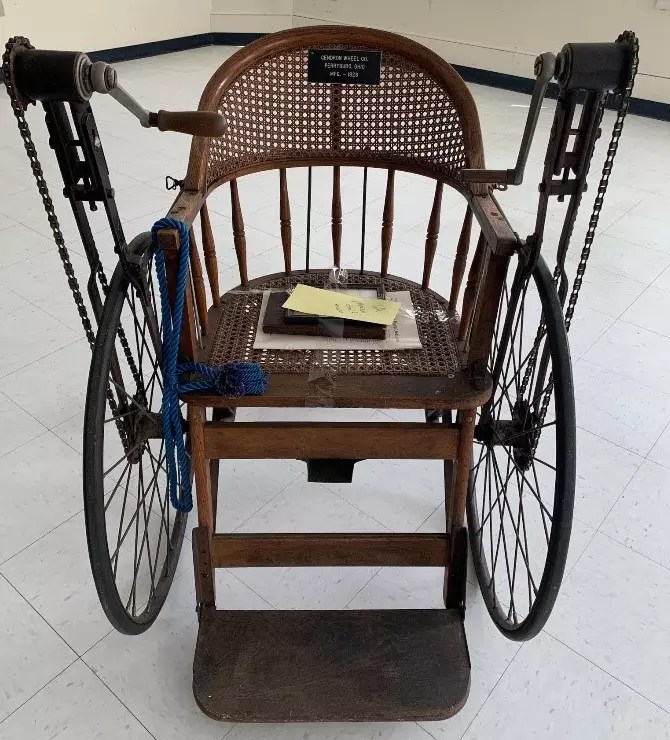Welcome to the first edition of the Curator Corner. This blog will be a place for our staff to share updates on the development of the National VA History Center (NVAHC), including exhibits and collections.
In June of 2021, trucks arrived at the temporary headquarters of the NVAHC at the VA Medical Center (VAMC) in Dayton, Ohio. These trucks contained “objects” that were originally collected for display at the Mountain Home VAMC in Johnson City, Tennessee. The NVAHC became their new home as their former home was being renovated for a new medical facility. Objects throughout the Department of Veterans Affairs (VA) need a permanent home to preserve them. We hope this was the first shipment of many helping us build a robust collection for future exhibition at the NVAHC museum.

Let’s start with an important but tricky question with many potential answers. What is a “museum?” Oxford dictionary defines it as “a building in which objects of historical, scientific, artistic, or cultural interest are stored and exhibited.” In Latin, it means library or study. The Greek word “mouseion” comes from a temple or shrine to muses. The American Alliance of Museums accepts all organizations that believe they are museums. Museums generally have two shared characteristics: they have a “collection” and they provide “education.”
How then, do museums acquire a collection that can be used for educational purposes? Many museums are created when an entire collection is donated, becoming the core of a new museum. The Field Museum in Chicago opened in 1894. It was established with a collection of objects from the World’s Columbian Exposition in 1893. At the close of the Exposition, the museum received a significant collection that has grown to around 40 million objects today. Like many museums, their collection started around a specific event.
When the President of the United States leaves office, their papers and the gifts they received are transferred to the National Archives and Records Administration (NARA), becoming a collection that can be displayed in a Presidential Library. This transfer creates a well-defined collection amassed during the years the President was in office. It reduces the need for active collecting by NARA, which makes it easier to define the mission and scope of a Presidential Library museum.
The NVAHC is not tied to a specific event, a singular rich benefactor, or a specific Presidential administration. It’s starting with a small collection of objects and archival material from the Dayton VAMC, and for the most part, staff will be building the collection from scratch. The trucks arriving from the Mountain Home facility represent only the first step in this journey. NVAHC staff will be reaching out to staff across the department to find things that will help tell the story of VA and its impact on the lives of Veterans. We will also be reaching out to Veterans and the general public.
So, what are we looking for? That is a great question, and while we have some ideas, we may not know we need something until we see it. If you have ever watched American Pickers, it can sometimes be like that. We could get a call from a person who says they have a piece of farm equipment used at the National Home for Disabled Volunteer Soldiers. That call might lead to one of our staff climbing around an old barn just like they do on TV. It has happened to me many times before while working for other museums. One time I climbed over a stall and put my head to close to a wasp nest. They are very protective of their nests. Another possibility is that someone will send us a picture of something they want to donate, and we will know right away that it tells an important story.

Building a collection can be exciting and dangerous—remember that old barn. I can tell you that Red Paper Wasps don’t play! Collecting can also be difficult. Often, we disappoint people who believe they have something that really belongs in a museum, but it may not be a good fit for our collection. At the end of the day, we are blessed to be able to interact with people who want to preserve history. They also tell great stories that we sometimes get to incorporate into the exhibits and programs. These connections to people and things make my job rewarding. Creating a new museum is exciting. We get to define the mission, shape the collection, present new programs, design the exhibits, and create a new facility within a historic one. This is why so many people tell us that they love history, and that we have a great job. We know we do! We hope that you are excited as we are about creating a NVAHC.
By Kurt Senn
Curator, National VA History Center
Share this story
Related Stories

Curator Corner
Bringing them Home: America’s WWII Burial Program
VA History is defined by public service to those who have fought for this country. For nearly 250 years, Americans have responded to the challenges Veterans face in innovative ways. But what happens for those who do not return home? This is the story of three Americans who paid the ultimate sacrifice fighting fascism in Europe, how each one was honored after death, and how the VA History Office is preserving their story.

Curator Corner
The Story Behind the National Homes’ Seal
The National Home for Disabled Volunteer Soldiers turns 160 years old in 2025. The campuses are the oldest in the VA system, providing healthcare to Veterans to this day.
At the time of their establishment, they were the first of their type on this scale in the world. Within the NHDVS seal is the story that goes back 160 years ago.



